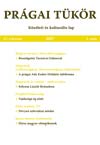
 |
| 2007/2 | resumé | ||
 tartalom e számunk szerzői bemutatkozik támogatóink
|
Summary
This year´s second issue of the Prágai Tükör magazine brings in the section Hungarian Destinies from Moravia to the West an interview with Gábor Tarnóczi, a native of southern Slovakian town Nové Zámky. Gábor Tarnóczi had come to Teplice in 1947 when his parents were deported for forced labour to the Czech lands on the basis of president Beneš´s decrees. A similar fate had befallen more than 40 000 Hungarians. Gábor Tarnóczi, who discusses his life in detail, does not nowadays feel bitter about his fate, however, he does not consider proper the events that took place after the end of the Second World War. The section Hungarians in Bohemia, in Moravia and in Silesia is almost fully dedicated to the 50th anniversary of the foundation of the Hungarian student organization of Endre Ady in Prague. Its former chairmen are reminiscing about its activities, whereas the anniversary celebrations are documented in the photo-reportage. Tünde Ambrus informs about the visit of the Hungarian president László Sólyom to Brno and about his participation at the summit of Central European presidents, as well as about his meeting with Hungarians living in this Moravian city. An interesting reportage by Péter Sinkovits about a Hungarian minority in Serbian Vojvodina is in the section From Prague to Bucharest. József Szilvássy introduces three Hungarian theatres in Slovakia in a detailed reportage, he also discusses both history and future of Hungarian theatres in Slovakia. Material about Hungarian Olympic winners was prepared by a sports journalist Vince Tomi. He further gives notice about a report about Czechoslovak Olympic winners who will be presented in the next issue of this magazine. Extracts from Czech literature - short prose by Alexandra Berková - were translated by Margit Zádor. The appendix Tükörkép provides information about the days of Hungarian culture in Teplice, about the meeting of the fans of culture in Prague at the event Consonance, and about the national assembly of the movement Coexistentia. Further reports are dealing with the issues of laying wreaths to the memorials of Hungarian soldiers in Zlatá Koruna and with the problems of the introduction of the European charter of minority languages in the areas of northern Moravia, which contain Polish minorities. The interpreter Kateřina Horváthová is discussing perception of Hungarian culture in the Czech Republic. A children's section is again a part of the appendix.
|
||